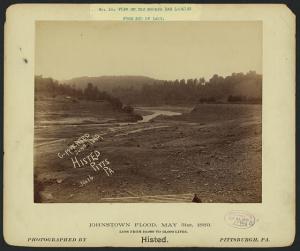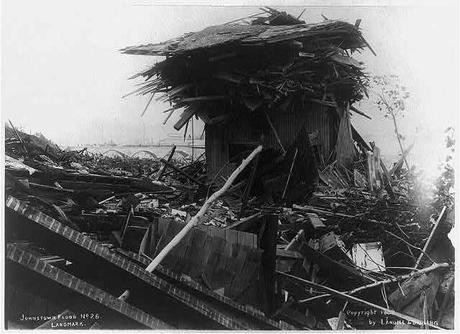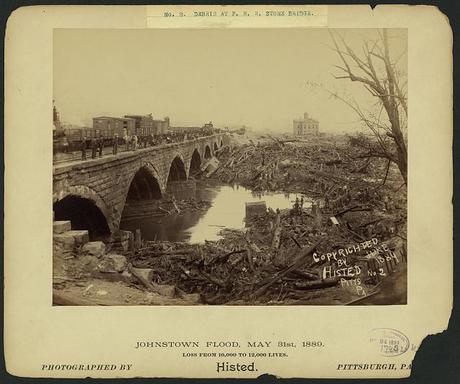
View of the broken dam looking from bed of lake (Credit: Library of Congress)
The year was 1889. The South Fork Dam in Pennsylvania had existed since 1838 when construction began on it (but was not actually finished until 1852). For years there had been talk about the possibility of the dam giving way and unleashing the body of water called Lake Conemaugh, which was held behind the dam. So far those fears had come to naught although there had been a scare in 1862. Over the years the lake had switched hands before landing itself in the holdings of wealthy businessmen. It was this group who constructed a resort around the lake, calling it the South Fork Fishing and Hunting Club.
With the lake came the responsibility of keeping up the dam. Unfortunately it would seem that despite its continual deterioration only very small efforts were made to keep it in working order. In 1880 inspections revealed the dam was seriously lacking and it was surmised that if the lake’s water levels reached a certain height the dam would go. The club president brushed the warnings away and, in effect, told the man that he was completely wrong. In Woodvale, the Cambria Iron Company went so far as to offer to help pay the expenses of repairs. But no. The club wanted to hear nothing more of it. But it was only a matter of time before something bad happened. That day was May 31.
The morning of 31 May 1889 was turning out to be very uncomfortable. The rain was coming down and all morning the two rivers around Johnstown had been steadily rising. Parts of town were already flooded and being abandoned as townspeople evacuated their homes for higher ground. Before noon rolled around several bridges were destroyed by the rising rivers. Sadly, one life had been claimed; a man helping evacuate a family was drowned.
Like the rivers, Lake Conemaugh was steadily rising. Those present at the club feared for the dam and efforts were underway to build the dam up and dig spillways. But everything was happening so fast that the work was met with little success. A man named John Parke raced into South Park, the town located below the dam, to warn people. But his arrival was not regarded as seriously as could be hoped. There had always been talk of the dam going, but nothing had ever happened. The townspeople had grown accustomed to living in the dam’s shadow and although they may have talked, most believed the dam would hold. Parke also recommended Johnstown be warned.

Debris in Johnstown (Credit: Library of Congress)
Emma Ehrenfeld was on a telegraphist on duty in South Fork when Parke’s warning came. When a man came by to tell her to warn Johnstown she was skeptical. She called up another station and got that operator’s opinion. From him she learned that the lines to Johnstown were down due to flooding. The operator assured Ehrenfeld that he would get someone to take the message to Johnstown though. The message eventually arrived, but like South Fork the town largely disregarded the danger. Another message soon followed to state that water was spilling over the South Fork dam. But still the majority of people remained indifferent to the disaster about to take place.
Around 3:00 p.m. the dam gave way. Lake Conemaugh spilled down the mountainside, greedily licking up whatever was in its path. In a little more than half an hour the reservoir had emptied itself and was racing across the Pennsylvanian landscape. The telegraph tower Ehrenfeld had been occupying with two others was destroyed, but not before the trio escaped it. After tearing through South Fork and claiming the first of its victims, the flood went through Mineral Point, East Conemaugh and then to Woodvale. So far it had left behind scraps of land that little resembled the towns they had once been. Woodvale lost over 300 people before the flood moved onto Johnstown. By that time the flood was mde up of more than water. It carried tons of debris, barbed wire and corpses
At about 4:07 p.m. the flood hit Johnstown. Townspeople who seen, or rather, heard it coming were often too shocked to do anything but watch it come hurling towards them, a dark ugly mass that stood about 36 feet high in the middle. For others there was not enough time to react. Traveling in front of the wave was a strong wind which was strong enough to collapse small buildings.
Smashing through Johnstown the waves smacked into a hill which it bounced off of and then took off in several directions. Some of the water managed to reach areas that the Conemaugh River had been unable to. The quick current carried homes, trains and people away on wild rides. Victor Heiser was coming out of the family barn when he noticed his father in the second-story of their home waving Heiser back into the barn. Heiser scrambled in and onto the roof. The barn was swept away and when it neared other waterborne houses he jumped from structure to structure. Hesier would survive the ordeal but he would lose both of his parents to the flood.

Debris at the stone bridge (Credit: Library of Congress)
Piles of debris came to rest at a surviving stone bridge. Among its contents were houses which still held living people. Anywhere from 500-600 people were trapped in the pile. When it caught fire the tortuous screams of the dying carried across town. Some brave souls were able to rescue individuals from the flames, but the majority of the trapped died. In a town that had lost electricity, the flames lit up areas of Johnstown.
The night was long and difficult. Some buildings were still standing and provided shelter for the dying and living. Fires were feared and the possibility of one building, Alma Hall, collapsing was also thought of. Thankfully they held up.
In the aftermath more than $3,000,000 was raised worldwide. In the States Americans rallied to send in supplies, money and people to lend a hand. Suffice it to say the boomtown Johnstown and its resilient population did rebuild, but the Johnstown Flood which claimed 2,209 lives would forever hold a place in the memory of Americans.
Source: McCullough, David. The Johnstown Flood: The Incredible Story Behind One of the Most Devastating Disasters America Has Ever Known.

